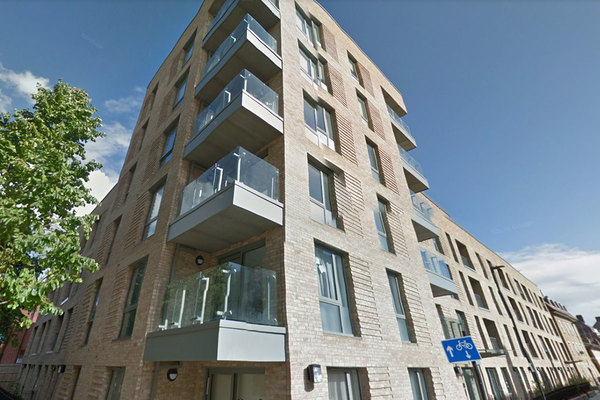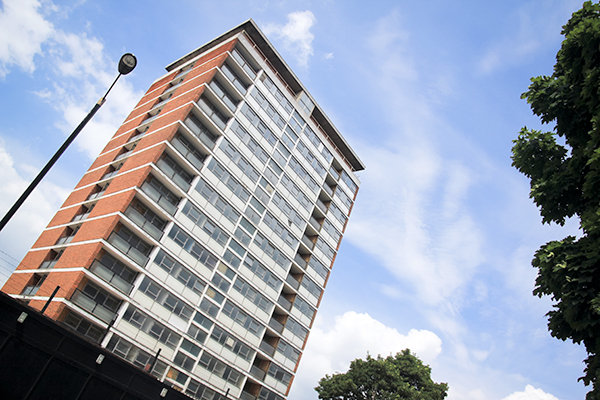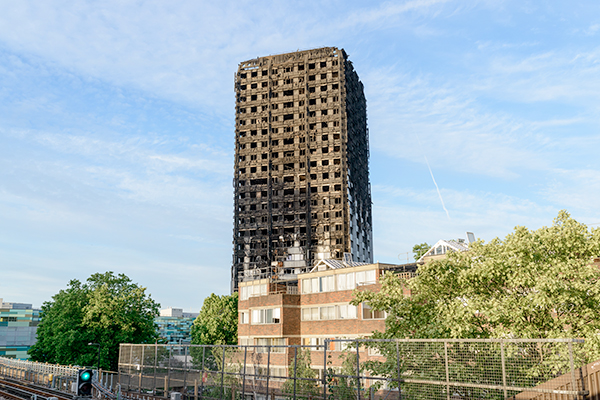You are viewing 1 of your 1 free articles
Private tower block with cladding that has failed government tests has waking watch removed
A privately owned tower block with cladding that has failed the government’s fire safety tests has had its waking watch removed after experts claimed the development meets building regulations.
The Palm and Malt House development in Lambeth is made up of three blocks, one of which is over 18 metres. The blocks had a waking watch in place after the combination of cladding used on the development failed government fire safety tests carried out in the wake of the Grenfell Tower fire.
The tallest building, which is over 18 metres, has aluminium composite material (ACM) category two with phenolic foam insulation on one floor of the building.
In a letter to residents, DJC Property Management said the waking watch would be removed following a review by the National House Building Council (NHBC) which concluded the development complied with building regulations in place at the time of construction and advice from fire safety consultants.
The NHBC report made no comment on the removal of the waking watch.
But residents are concerned about the removal of the waking watch which has left the building with no interim fire safety measures in place.
Bellway, the developer of the blocks, also hired fire consultants who advised that “the buildings are safe without the need for a waking watch and the London Fire Brigade have removed their objection of the removal of the waking watch,” the letter said.
It added: “We hope it is reassuring to residents that these experts all agree the buildings are safe and no further costs will need to be incurred for temporary safety measures.”
Bellway will cover the £150,000 cost of the waking watch. The management company had sought to go to tribunal to decide how much residents should pay towards the fire safety costs, but this has now been cancelled, the letter said.
The letter said the management company will now seek to clarify whether the ACM cladding needs to be replaced but “this is likely to take some time whilst government guidance is developed and the Grenfell enquiry [sic] proceeds”.
The development includes flats that are owned by Peabody.
A resident who wished to remain anonymous said: “Whilst we welcome the offer by the developer to pay the considerable costs to date of the waking watch, we are very concerned by the recent termination of the waking watch after seven months by the managing agent, which has left the building with no interim fire safety measure in place. The dangerous cladding and insulation remains on the building and residents are wondering whether in fact they are safe, how long it will take for the cladding to be replaced and who will be asked to pay for it in the long run. This is causing a great deal of stress and uncertainty for everyone.”
A London Fire Brigade spokesperson said: “The competent person for Palm and Malt House have recently undertaken more detailed analysis and assessment, and they have now determined that a return to stay put is achievable.”
The managing agents put a claim in to NHBC under the 10 year warranty leaseholders hold to cover the potential cost of replacing the cladding.
A spokesperson for NHBC said following a “detailed technical assessment” it found the buildings “did comply with the building regulations at the time of the construction and therefore the claim made against the warranty for the potential cost of any repairs was not valid”.
The ‘Class 0’ debate explained
- Since the Grenfell Tower fire, the government has insisted that its official guidance, Approved Document B, required cladding panels to be of ‘limited combustibility’. But many industry figures disagree, saying that the standard the guidance set was ‘Class 0’ or ‘Euroclass B’.
- Approved Document B sets limited combustibility as the standard for ‘insulation materials/products’ in paragraph 12.7. It sets Class 0 or Euroclass B as the standard for ‘external surfaces’ in paragraph 12.6.
- Paragraph 12.7 says that “insulation product, filler material etc” must be of limited combustibility. In a letter to social landlords on 22 June, the government said that the word ‘filler’ in this context covered the plastic in between the aluminium sheets in the cladding.
- But experts have disputed this view, pointing out that the cladding itself does not have an insulation function.
- The cladding used on Grenfell was certified to Class 0 and so would apparently have met the official standard for external walls.
- This debate remains crucial in assessing the liability for the removal of cladding, much of which is also rated Class 0, from hundreds of tower blocks nationwide.













